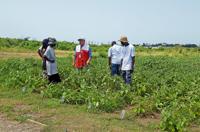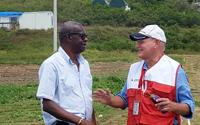Stronger hurricanes becoming the norm — and that’s stumping researchers, meteorologists and computers
The huge mahogany trees were shattered stumps. Everywhere you looked, the normally leafy island was brown.
More than half the homes were damaged or destroyed and nearly everyone was without power or water.
Hurricane Irma in 2017 wasn’t predicted by computer models to put that powerful a hit on the American Virgin Islands. But she did, joining a number of hurricanes in the past few years that have been stumping the computer forecast models.
They are strengthening faster and in unexpected places. They are lasting longer and occasionally still not going where computers say they should.
They beg the question: Are the forecast models struggling to catch up to what appears to be warming in the atmosphere and the oceans?
The answer appears to be yes. And they are stumping researchers and meteorologists just when they thought they were finally getting a bead on the storms.
Stronger winds
The strongest storms ever recorded emerged in the past few years, including Hurricane Patricia with tornado-like 215 mph winds off Mexico in 2015.
Researchers are now eyeing the prospect of that becoming more common.
In June, the National Oceanic and Atmospheric Administration released a report that said while it is too soon to scientifically determine whether climate warming caused by fossil fuel burning was having an impact on hurricanes in the Atlantic, the warming might already have caused changes that “aren’t confidently modeled” in the computers.
The new uncertainties leave coastal residents in South Carolina and elsewhere a little edgier as the Atlantic basin moves into the mid-August to mid-October months that normally produce the most — and worst — hurricanes of the season.
Eleven months after Irma, Bill Martin, an Isle of Palms resident, is still in the Virgin Islands working with farmers.
He and others eyed Hurricane Beryl warily in July as it roared toward Barbados 500 miles away. Beryl too had stumped the computer forecast runs, which called for it to be no stronger than a tropical storm.

The 72-year-old is a former insurance executive and a health care consultant who has volunteered with the Red Cross for 20 years. He was in the Gulf states after hurricanes Katrina and Rita wracked them in 2005. But what he saw in the Virgin Islands staggered him.
St. Croix, where Martin is headquartered for the time being, is still a town of “blue roofs,” homes with tarps draped to cover where the roofs were blown away. Only two of the islands’ 25 emergency shelters can be used. The others are still in shambles.
After Irma and Maria last year, “debris was everywhere,” he said.
“The big push was to clear the roads to move emergency vehicles,” he said.
When Beryl loomed, “a lot of people just said, ‘This is too much,’ ” he recalled.
Martin will be in the Virgin Islands until October to finish up the recovery work — hopefully without another powerful storm striking.

Martin’s focus with the farmers is helping them replace outbuildings and equipment destroyed by the storm.
“We try to tell them the weather is changing, so whatever they install to make sure they’re accommodating for strong winds,” he said.
‘Low confidence’
Tweaking the computer models is a constant, and they are continuing to improve as they go.
But already this year they have been stumped by at least two storms. Tropical Storm Debby last week emerged in cold waters in the north Atlantic where the computer runs forecast it would die away.
Before Debby, runs by two of the more reliable models forecast a tropical storm in the Pacific to move to locations some 1,200 miles apart — a fifth of the width of the ocean. Uncertain how to adjust for that, National Hurricane Center specialist Eric Blake left an earlier track forecast in place, noting it was a “low confidence” prediction.
“In theory, the models shouldn’t care how the climate is changing, since the models simply solve the mathematical equations that govern the physics of how the atmosphere works,” said meteorologist Jeff Masters of the private forecasting company Weather Underground.
But in practice, he said, researchers have to adjust the models when their runs consistently aren’t accurate.
The hurricane center in 2009 launched a 10-year forecast improvement program just to get a better bead on rapid intensification of the storms — the occurrence the models have the most trouble predicting. In 2016, a number of intensifying storms gave them enough data to work with.
In 2017, the models correctly forecast only six of 39 instances where storms intensified or lost power rapidly. But in 2009 that forecast would have been zero, said Michael Brennan, the branch chief of the hurricane specialist unit.
MIT climate researcher Kerry Emanuel recently released a study that cites the potential of a warmer climate to affect the frequency, intensity and tracks of the storms.
“Hurricane track forecasts have improved steadily over the past few decades, yet forecasting hurricane intensity remains challenging,” Emmanuel said in the study.
“As the climate continues to warm, hurricanes may intensify more rapidly just before striking land, making hurricane forecasting more difficult.”
